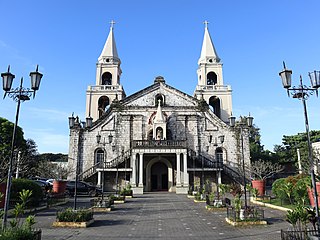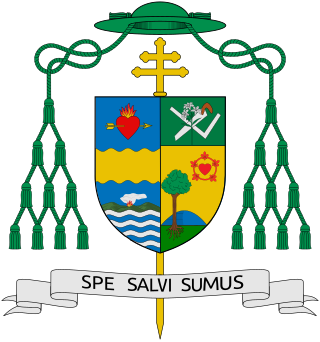
The Cathedral of the Savior or La Seo de Zaragoza is a Catholic cathedral in Zaragoza, in Aragon, Spain. It is part of the World Heritage Site Mudéjar Architecture of Aragon.

The Metropolitan Cathedral of Our Lady Assumption and Saint Paul, also known as the See Cathedral, is the cathedral of the Roman Catholic Archdiocese of São Paulo, Brazil. Its current and seventh metropolitan archbishop is Dom Odilo Pedro Cardinal Scherer, appointed by Pope Benedict XVI on March 21, 2007, and installed on April 29 of the same year. The existing cathedral's construction, in a Gothic revival style, began in 1913 and ended four decades later. It was ready for its dedication on the 400th anniversary of the foundation of the then humble villa of São Paulo by Chief or Cacique Tibiriçá and the Jesuit priests Manuel da Nóbrega and José de Anchieta. Despite its Renaissance-style dome, the São Paulo Metropolitan Cathedral is considered by some to be the fourth largest neo-Gothic cathedral in the world.

The Archdiocese of Zamboanga is a Catholic archdiocese in the Philippines. Its present jurisdiction includes Zamboanga City, with suffragans in Basilan, Zamboanga Sibugay, and the Apostolic Vicariate of Jolo. It became Mindanao's first diocese in 1910, and was established as the second archdiocese of Mindanao in 1958. Today, the archdiocese covers a land area of 1,648 square kilometers and has a population of 442,345, of which 81 percent are Catholics. The archdiocese includes 28 parishes and one quasi-parish, served by 57 diocesan and 18 religious priests. There are also 51 religious sisters working in the archdiocese.

The Archdiocese of Nueva Segovia is an archdiocese of the Catholic Church in the Philippines. It covers the province of Ilocos Sur, on the island of Luzon. The see of the archdiocese is the city of Vigan.

The Archdiocese of Cebu is a Latin Church archdiocese of the Catholic Church in the Philippines and one of the ecclesiastical provinces of the Catholic Church in the country. It is composed of the entire civil province of Cebu. The jurisdiction, Cebu, is considered as the fount of Christianity in the Far East.

The Roman Catholic Archdiocese of Ozamis is a metropolitan archdiocese of the Roman Catholic Church in the province of Misamis Occidental, southern Philippines. The archdiocese cathedral is the Metropolitan Cathedral of the Immaculate Conception in Ozamiz City, and its present archbishop is Martin Jumoad. The official spelling of the church is Ozamis, while the city it is located is Ozamiz.

The Roman Catholic Archdiocese of Cagayan de Oro is an archdiocese of the Catholic Church in the Philippines.

Antonio Javellana Ledesma, is a Filipino Roman Catholic clergyman who served as the Archbishop of the Metropolitan Archdiocese of Cagayan de Oro in the Philippines from 2006 to 2020.

Patrick Henry Cronin, was an Irish, Roman Catholic, Columban archbishop and missionary. He was the second Archbishop of Cagayan de Oro in the Philippines, serving during World War II.

James Thomas Gibbons Hayes, was an American, Roman Catholic, Jesuit archbishop and missionary who served as the first Archbishop of Cagayan de Oro in the Philippines.

The National Shrine of the Our Lady of Candles, also known as the Metropolitan Cathedral of Saint Elizabeth of Hungary and colloquially as Jaro Cathedral, is a cathedral located in the district of Jaro in Iloilo City, on the island of Panay in the Philippines. The seat of the Roman Catholic Archdiocese of Jaro, it was placed under the patronage of Saint Elizabeth of Hungary. It was established in 1575 as a visita (chapel-of-ease) of Oton by the Augustinians and as a separate parish in 1587. The present-day structure of Jaro Cathedral was built in 1874.

Cagayan de Oro (CDO), officially the City of Cagayan de Oro, is a highly urbanized city in the region of Northern Mindanao, Philippines. According to the 2020 census, it has a population of 728,402 people, making it the 10th most populous city in the Philippines and the most populous in Northern Mindanao.

The Metropolitan Cathedral and Parish of Saint John the Evangelist, also known as the Naga Metropolitan Cathedral, is a Roman Catholic cathedral in Naga, Camarines Sur, Philippines. It is the seat of the Archdiocese of Caceres. The first church was established after the creation of the archdiocese as the Diocese of Nueva Cáceres in 1595. The present cathedral was built in 1808, and was completed and consecrated in 1843.

Immaculate Conception Parish Church, commonly known as Jasaan Church, is a Baroque Roman Catholic church located in Poblacion, Upper Jasaan in Misamis Oriental, Philippines. It is under the jurisdiction of the Archdiocese of Cagayan de Oro. The church was declared by the National Museum as a National Cultural Treasure in Northern Mindanao due to its artistic design and cultural values.

San Agustin Parish Church, commonly known as Lubao Church, is a 17th-century Neo-classic, Spanish stone and brick Roman Catholic church located at Brgy. San Nicolas 1st, Lubao, Pampanga, Philippines. It is under the jurisdiction of the Archdiocese of San Fernando. In 1952, a historical marker bearing a brief history of the structure was installed on the facade of the church by the Historical Committee of the Philippines, precursor of the National Historical Commission of the Philippines. In 2013, the church has been declared by the National Museum of the Philippines as an Important Cultural Property.

Saint Peter Metropolitan Cathedral, commonly known as Tuguegarao Cathedral, is an 18th-century Baroque Roman Catholic church located along Rizal Street, Barangay Centro 10, Tuguegarao, Cagayan, Philippines. The church, originally built by Dominican friars, is the seat of the Archdiocese of Tuguegarao and is considered one of the largest churches in the Cagayan Valley. A historical marker bearing a brief history of the church was installed in 1982 by the National Historical Institute, precursor of the National Historical Commission of the Philippines.

San Pedro Cathedral Parish, also known as the Metropolitan Cathedral of San Pedro, is a Roman Catholic cathedral located at Barangay 2-A, Poblacion District, Davao City, Philippines. The cathedral, dedicated to Saint Peter, is the ecclesiastical seat of the Archdiocese of Davao.
DXFO, broadcasting as 91.9 Marian Radio, is a radio station owned and operated by the Archdiocese of Cagayan de Oro. The station's studio and transmitter is currently located at Saint Augustine Metropolitan Cathedral, Brgy. 1, Cagayan de Oro.

José Araneta Cabantan is a Filipino prelate of the Catholic Church, serving as the archbishop of the Latin Church Metropolitan Archdiocese of Cagayan de Oro in the Philippines.

























